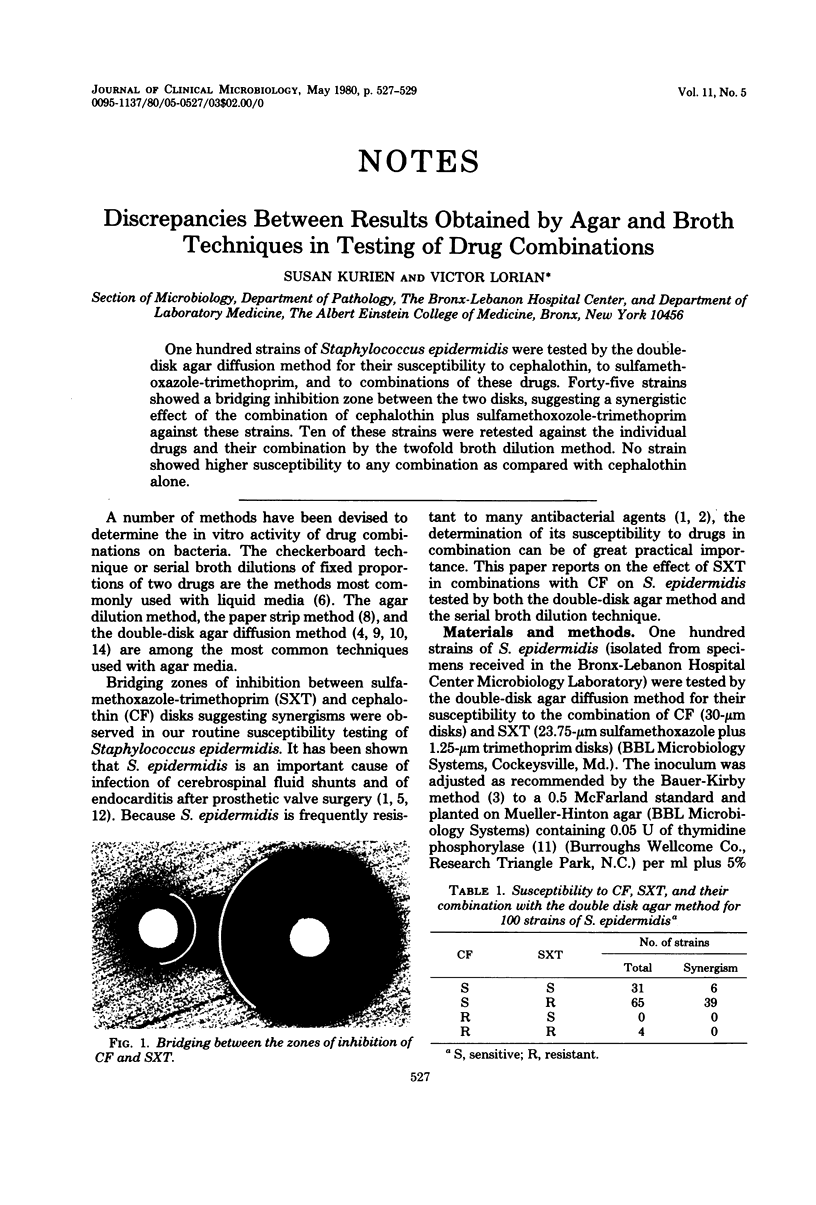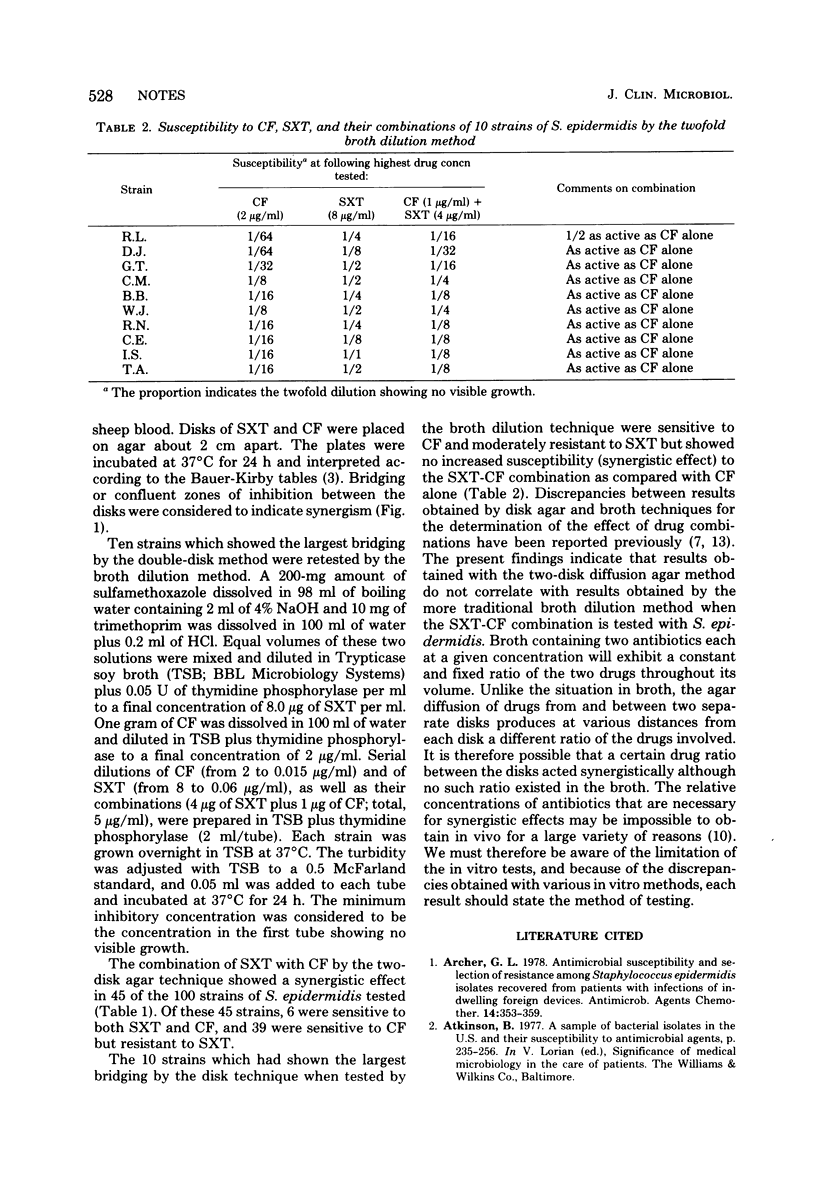Abstract
One hundred strains of Staphylococcus epidermidis were tested by the double-disk agar diffusion method for their susceptibility to cephalothin, to sulfamethoxazole-trimethoprim, and to combinations of these drugs. Forty-five strains showed a bridging inhibition zone between the two disks, suggesting a synergistic effect of the combination of cephalothin plus sulfamethoxozole-trimethoprim against these strains. Ten of these strains were retested against the individual drugs and their combination by the twofold broth dilution method. No strain showed higher susceptibility to any combination as compared with cephalothin alone.
Full text
PDF


Images in this article
Selected References
These references are in PubMed. This may not be the complete list of references from this article.
- Archer G. L. Antimicrobial susceptibility and selection of resistance among Staphylococcus epidermidis isolates recovered from patients with infections of indwelling foreign devices. Antimicrob Agents Chemother. 1978 Sep;14(3):353–359. doi: 10.1128/aac.14.3.353. [DOI] [PMC free article] [PubMed] [Google Scholar]
- Bauer A. W., Kirby W. M., Sherris J. C., Turck M. Antibiotic susceptibility testing by a standardized single disk method. Am J Clin Pathol. 1966 Apr;45(4):493–496. [PubMed] [Google Scholar]
- Dismukes W. E., Karchmer A. W., Buckley M. J., Austen W. G., Swartz M. N. Prosthetic valve endocarditis. Analysis of 38 cases. Circulation. 1973 Aug;48(2):365–377. doi: 10.1161/01.cir.48.2.365. [DOI] [PubMed] [Google Scholar]
- GARROD L. P., WATERWORTH P. M. Methods of testing combined antibiotic bactericidal action and the significance of the results. J Clin Pathol. 1962 Jul;15:328–338. doi: 10.1136/jcp.15.4.328. [DOI] [PMC free article] [PubMed] [Google Scholar]
- Gray J., McGhie D., Ball A. P. Serratia marcescens: a study of the sensitivity of British isolates to antibacterial agents and their combinations. J Antimicrob Chemother. 1978 Nov;4(6):551–559. doi: 10.1093/jac/4.6.551. [DOI] [PubMed] [Google Scholar]
- Lorian V., Fodor G. Technique for determining the bactericidal effect of drug combinations. Antimicrob Agents Chemother. 1974 Jun;5(6):630–633. doi: 10.1128/aac.5.6.630. [DOI] [PMC free article] [PubMed] [Google Scholar]
- Möller O., Holmgren J. A paper disc technique for studying antibacterial synergism. Acta Pathol Microbiol Scand. 1969;76(1):141–145. doi: 10.1111/j.1699-0463.1969.tb03242.x. [DOI] [PubMed] [Google Scholar]
- Paisley J. W., Washington J. A., 2nd Synergistic activity of gentamicin with trimethoprim or sulfamethoxazole-trimethoprim against Escherichia coli and Klebsiella pneumoniae. Antimicrob Agents Chemother. 1978 Nov;14(5):656–658. doi: 10.1128/aac.14.5.656. [DOI] [PMC free article] [PubMed] [Google Scholar]
- Schoenbaum S. C., Gardner P., Shillito J. Infections of cerebrospinal fluid shunts: epidemiology, clinical manifestations, and therapy. J Infect Dis. 1975 May;131(5):543–552. doi: 10.1093/infdis/131.5.543. [DOI] [PubMed] [Google Scholar]
- Waterworth P. M., Emmerson A. M. Dissociated resistance among cephalosporins. Antimicrob Agents Chemother. 1979 Apr;15(4):497–503. doi: 10.1128/aac.15.4.497. [DOI] [PMC free article] [PubMed] [Google Scholar]
- Yourassowsky E., Vanderlinden M. P., Schoutens E. A Rapid, simple method for demonstrating synergy of amikacin and penicillin against various microorganisms. J Infect Dis. 1976 Nov;134(Suppl):S275–S279. doi: 10.1093/infdis/135.supplement_2.s275. [DOI] [PubMed] [Google Scholar]



